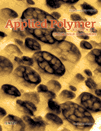Silicone rubber/polyvinylpyrrolidone microfibers produced by coaxial electrospinning
Abstract
Core-shell structured silicone microfibers were prepared by coaxial electrospinning using polyvinylpyrrolidone (PVP) as the shell and silicone rubber (SR) as the core. The electrospinnability of SR at three time windows was evaluated and the electrospinning process was optimized accordingly. A positive correlation was found between the fibrous morphology and the SR/PVP speed ratios. As the speed ratio increased, the composite fiber showed larger diameter and wider diameter distribution. For the fibers prepared at PVP/SR speed ratios of 1.7/2.5 and 3.5/2.5 (mL/h), the fibrous structure remained intact after immersion in water for 8 h. The pure SR microfiber could be made from the composite after immersion in water, which can be potentially used as stretchable and selectively permeable membranes for chemical protective applications and in plastics toughening. © 2012 Wiley Periodicals, Inc. J. Appl. Polym. Sci., 2013




